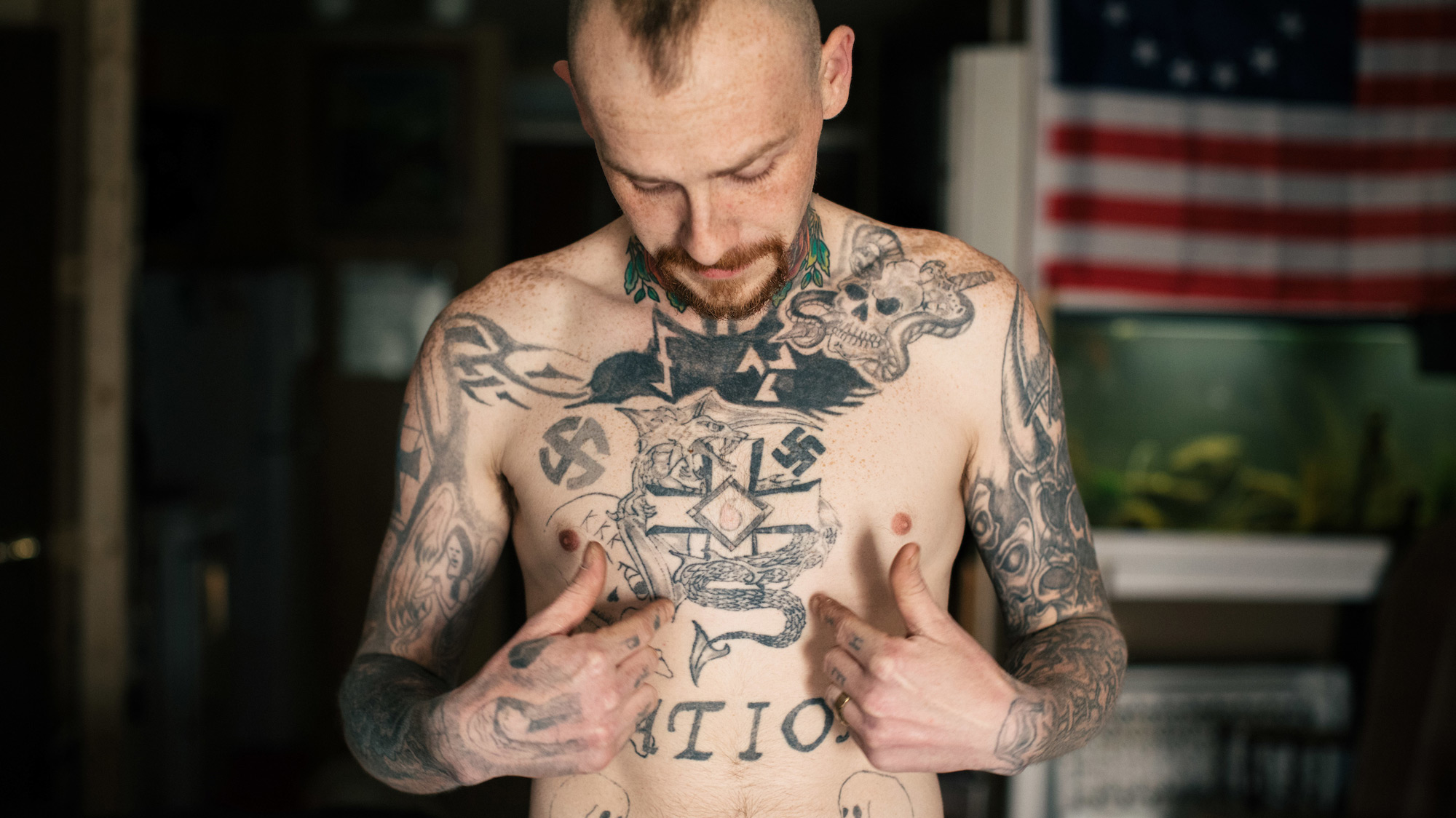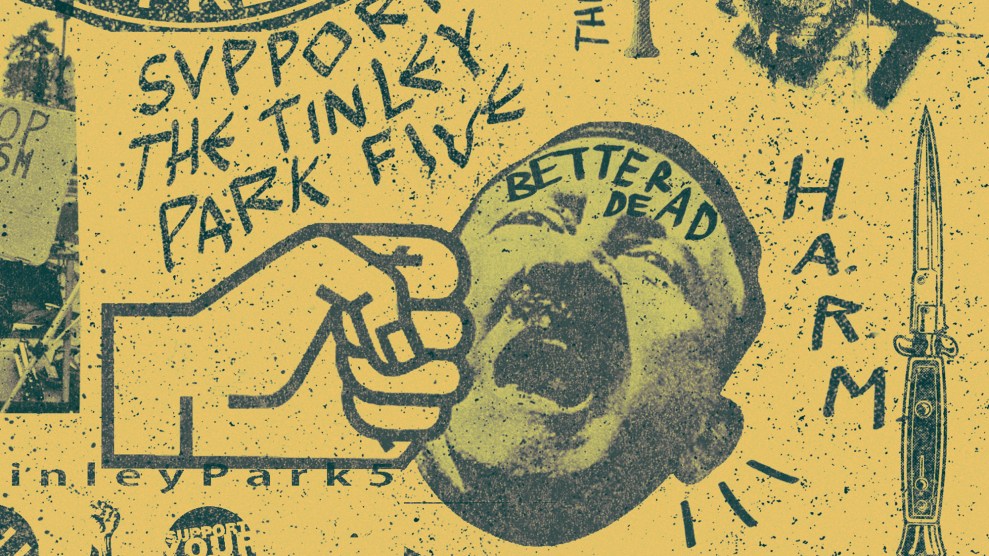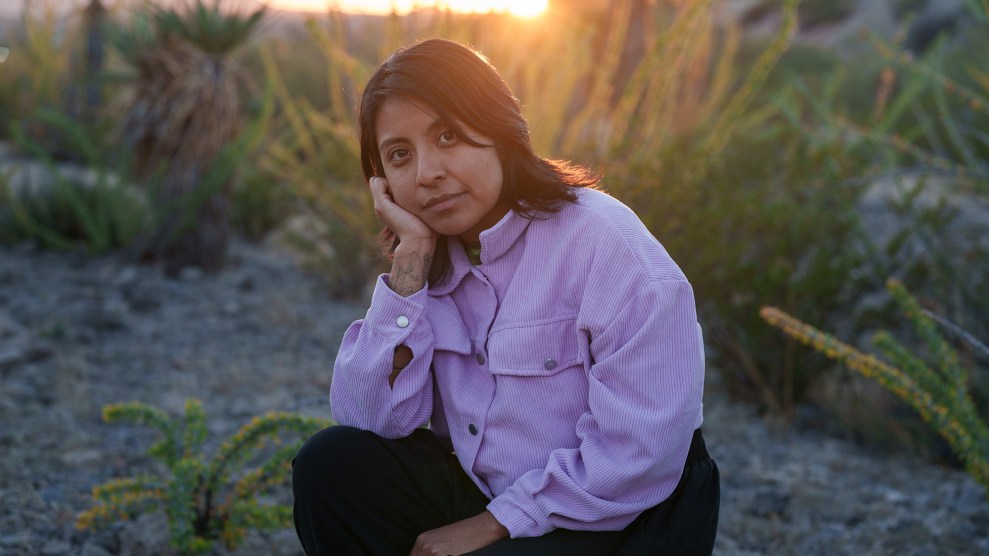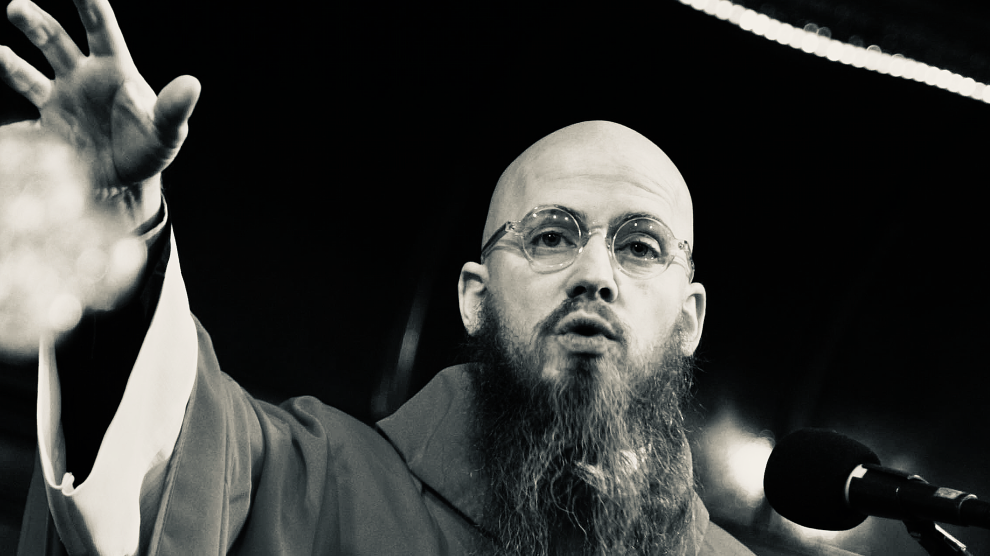On July 4, 2013, one of Shane Johnson’s pals pushed through the front door of his trailer and announced that “a bunch of black guys” had just “said some shit to him.” Johnson was small and lithe, tattooed from neck to toe with swastikas, and his throat was inked with a portrait of Jesus and the words “I AM NOT A JEW.” As a teenager, he’d earned the nickname “Punchy” for his willingness to make up for his stature with an even shorter temper. It served him well as the leader of his Ku Klux Klan chapter in Kokomo, Indiana.
On his orders, he and several of his buddies tied bandannas to padlocks and stuffed them into their back pockets. Johnson, who had been awake for three days on an Adderall and whiskey bender, led his posse to a nearby park where a band was performing an Independence Day concert for a crowd of families. Johnson didn’t see the kids who had trash-talked his friend, but on the edge of the grass he spotted something even more offensive—an African American man and a white woman sitting on a blanket holding hands. He and his crew fanned out, swinging their padlocks at anyone within reach, shouting, “White power, you niggers!”
Indiana has long been a hotbed of white supremacist activity. In 1923, Kokomo hosted the largest KKK rally in US history. Two years later, half the city’s residents were Klan members. Today, infamous movement leaders like White Aryan Resistance founder Tom Metzger and alt-right figurehead Matt Heimbach live in the state, and Klan branches remain active in major cities. Johnson grew up in one of Kokomo’s best-known Klan families; his dad even appeared in full robe and hood on The Jerry Springer Show in the ’90s. “Nobody liked me,” he says. “I didn’t have any friends or anything.”
Starting at the age of five, he received two hours of daily Bible study from his dad. He was schooled in the doctrine of “Christian Identity,” which holds that the enslavement or extermination of all nonwhites will usher in the second coming of Christ. In kindergarten, Johnson got in trouble for refusing to sit next to a black child. He dropped out in seventh grade to dedicate himself to the march toward racial Armageddon. “We was told we’d go to eternal damnation if we didn’t fight Jews and blacks,” he says. “That’s some scary shit for a young kid.”
Yet in the months before the attack in the park, Johnson had had flashes of doubt, moments when his indoctrination and reality didn’t seem to match up. There was the “proof” that Adam and Eve were Caucasian—something about how the sand in Eden was white—which “just didn’t make any damn sense.” He’d started to feel pangs of embarrassment about getting that Jesus neck tattoo. But the most troubling moment came one day as he and his girlfriend, Tiffany Gregoire, were driving around and she asked him, “If there was a black baby right here and you could kill him or her and get away with it, would you?”
“Fuck yeah, I would,” Johnson remembers answering. “That would potentially stop a whole bunch of black people from being born. I don’t believe they have souls, anyway. It’d be like killing a dog.”
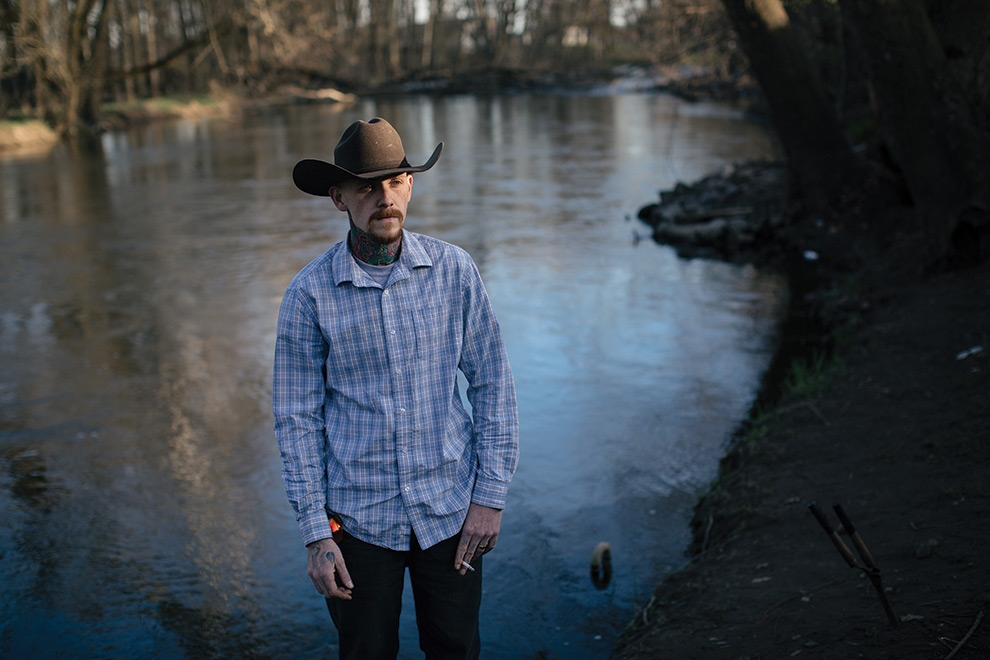
Alyssa Schukar
Gregoire, who had been dating Johnson since she was 17, grew up in a tolerant household in Georgia before moving to Indiana. She had been gently prodding him since they met, introducing him to rap music, or “seed planting,” as he would later realize. But even though she wished he’d change, she didn’t like confrontation and loved Johnson despite his beliefs.
“What, you think less of me or something?” he said, noticing her disappointment.
“No, no, that’s fine,” she said, turning the music up. “I don’t care. I was just wondering.”
As he drove near the route where 200,000 Klan supporters had marched in 1923, he had an inkling of an epiphany, which he tried to put out of his mind. Nah, hell no I wouldn’t murder a black baby, he thought. There’s no fucking way.
If he actually believed in white supremacy and race war, what did this hesitation mean? In the past, he might have asked his dad, a lifelong Klan member, who would have rebuked him and reminded him that doubt was Satan talking. But for the first time, Johnson wasn’t sure he wanted to know what his father would say. When his dad died in mysterious circumstances soon afterward, it was a mixed blessing. “It sounds bad,” Johnson recalls, “but I’m glad he died.”
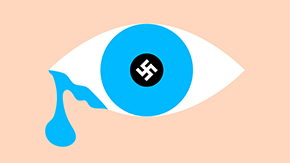
RELATED: You Can’t Understand White Supremacists Without Looking at Masculinity
That uncomfortable conversation with Gregoire popped into Johnson’s mind when he woke up in the Howard County jail the day after the park attack. During the seven months since his dad died, he’d been on a near-suicidal binge, drowning his anger and uncertainty in a sea of booze and pills. Now he was viciously sober, his head throbbing, his fists bruised and cut up, his neck and back aching from where the cops had kneed and punched and tased him. Johnson had hurt people before, but this time his hazy memories of what he’d done in the park made him feel guilty—the way the man on the blanket just went down after he thunked him over the head with the padlock, or how the white woman with two biracial children looked while he chased them screaming “nigger lover!”
Next to him in the cell, one of his friends just shrugged about the prospect of prison. “So, you think we’re going to join the Aryan Brotherhood when we get in there?” he asked. Johnson thought to himself, “What the fuck am I doing with my fucking life? How are we the supreme race? We’re fucking idiots.”
He suddenly realized he wanted to escape the Klan. But how? He was 22 years old, had no skills and no job, had $100 to his name, and was covered in white supremacist tattoos, and his criminal record was about to get longer. He’d hardly read any books except the Bible and the Kloran, the KKK’s secret handbook. He’d spent nearly every hour of his life dedicated to a vision of white supremacy that he wasn’t sure was so superior anymore. Besides Gregoire, he had virtually no friends outside the movement. If he turned his back on his family and crew, they might try to kill him.
Johnson was experiencing a reckoning that’s common for many white supremacists, a sort of ideological hangover after waking up from years of hate. Since Donald Trump rode a wave of racial resentment to the White House in 2016, America’s white supremacists have been emboldened. Yet as the movement’s visibility has increased, so has the number of extremists trying to escape it. Efforts to understand the minds of violent racists like Shane Johnson have gained newfound urgency as the country struggles to defeat the next generation of extremists.
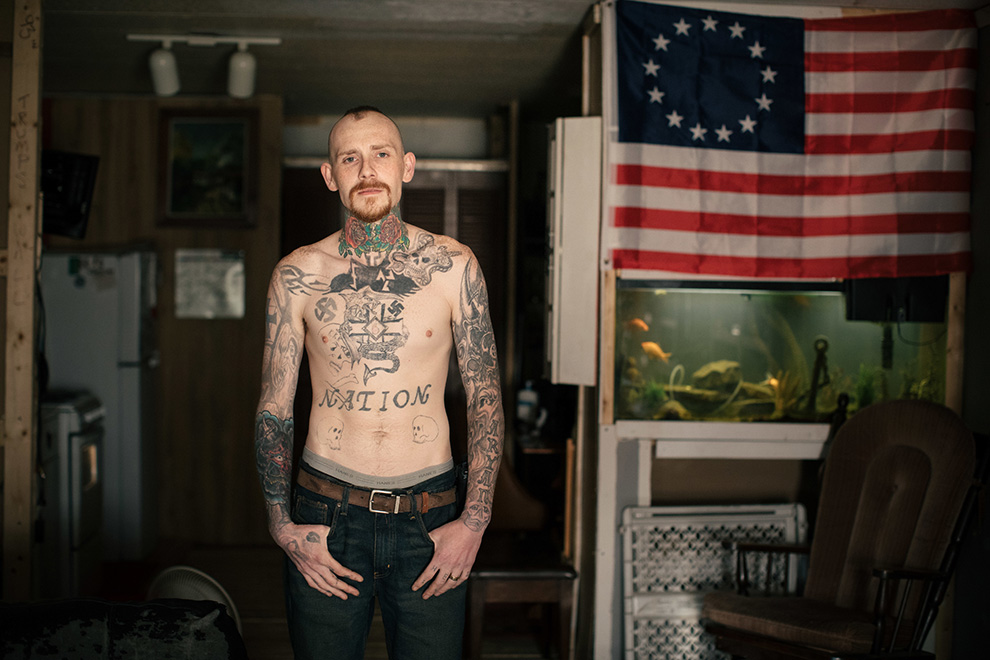
Alyssa Schukar
Leading this effort is a loosely affiliated group of scholars and activists, some of whom are former white supremacists themselves. The deradicalization movement combines insights gleaned from social work, 12-step programs, psychology, neurochemistry, and the personal experiences of “formers” who have left extremist groups. It’s tricky work. Few extremists make clean breaks with their past. Many liken hate to an addiction—hard to quit and easy to relapse into. The process is slow and one-on-one; it doesn’t promise to defeat hate groups so much as chip away at a movement that includes more than 400 organizations with thousands of members, according to the Southern Poverty Law Center—not to mention fellow travelers in the alt-right and online hate communities, bolstered by websites like the neo-Nazi Daily Stormer that cheer on racist violence. Deradicalization activists are, in turn, facing a crucible: Can their fragile, nascent project provide a new path to Americans like Johnson who want to leave hate behind?
How people join hate groups has been studied extensively, but researchers are still learning how people quit. Starting in the late 1980s, Tore Bjørgo, a Norwegian sociologist, interviewed white supremacists as they attempted to leave the Scandinavian neo-Nazi movement. His findings were counterintuitive: Many became hardcore racists only after they had joined white supremacist groups. Rather than preexisting anti-Semitism or xenophobia, a cocktail of experiences such as isolation, depression, anxiety, or childhood abuse typically served as the stepping stones to extremism. This suggested that the behavioral and social rewards of participating in hate groups are perhaps more fundamental to understanding—and stopping—extremist behavior than the ideology behind it.
Arie Kruglanski, a social psychologist at the University of Maryland and a Holocaust survivor, hit upon a related discovery: While researchers had believed that some combination of class, gender, geography, intelligence, and age determined who was most likely to become a white supremacist, Kruglanski found that psychological signposts were better predictors of radicalization. He called these factors “the three Ns”—need, narrative, and network. It doesn’t matter if they are skinheads or jihadis; everyone who gets involved in hate movements has a deep urge to participate in a greater cause. Yet that cause, Kruglanski argued, needn’t be destructive. To successfully deradicalize a neo-Nazi, a new, constructive set of Ns—which might stem from education, a job, a partner—would have to replace the old, hateful ones.
In 1997, Bjørgo helped create Norwegian Exit, the first group to put this growing body of research into practice. Staffed by social workers, the government-funded organization offered a place where people struggling to disengage from extremist groups could get access to therapy, learn new skills, and talk with job counselors. Just as importantly, participants could make friends outside their insular hate movements and meet Muslims, Jews, or immigrants whom they’d demonized yet had never interacted with personally.
While Exit sought to lure people away from neo-Nazi groups, it only focused on helping motivated extremists who wanted to get out, rather than trying to prevent new recruits from being radicalized. Fighting the neo-Nazi movement as a whole, Bjørgo and other Exit leaders believed, was a large-scale political task; Exit was there to provide a mostly apolitical refuge for individuals who’d grown disenchanted. The Exit model quickly spread to Germany, Sweden, and Finland. The success rates were astonishing: In Germany, only 8 out of 280 formers over a six-year period returned to hate groups. During a three-year period in Sweden, only 4 out of 133 relapsed.
Nothing similar existed in America when a former neo-Nazi in Wisconsin named Arno Michaelis started an online magazine called Life After Hate in 2010. Michaelis had found himself adrift after he’d abandoned the Hammerskin Nation and sought to take responsibility for his violent past. He’d never heard of Exit, and he didn’t realize so many people felt like him until he received letters from other former hate group members struggling with the transition to normal life. “Your story holds a very eerie resemblance to my own,” wrote Rob from Kentucky. “I just wanted to talk to some one who may relate to my life of regret.”
In 2011, Michaelis was invited to attend the inaugural Google Ideas Summit Against Violent Extremism in Dublin. There, he met some of his site’s contributors, a group of charismatic former white supremacists who would become America’s leading deradicalization activists. There was Christian Picciolini, an ex-member of the Hammerskin Nation in Chicago; Angela King, a former neo-Nazi leader from Florida; Tony McAleer, a former member of White Aryan Resistance in Canada; and Frank Meeink, an ex-Nazi from Philadelphia. And there was Sammy Rangel, who considered himself a former extremist because he had led a Latino gang that targeted whites. They joked about how, unlike the reformed jihadis at the conference, with their immaculate beards and smart suits, they were covered in tattoos and scars like a roadhouse rock band. “Our stories were all pretty much the same,” Michaelis recalls.
One night, they bonded at the hotel bar over their shared identities as “formers,” a term they’d just learned from their European counterparts. They realized that through their experiences of overcoming hate, they might repair the harm they’d caused others and begin to heal themselves. They had stumbled upon a collective redemption narrative that could offer another sense of meaning and belonging to hate group members hoping to build new lives. By the end of the trip, they had decided to create an American version of Exit. They named it Life After Hate.
Since 2011, Life After Hate has helped about 150 people disengage from extremist ideologies. Unlike the original Exit group, it is composed mostly of formers and has largely operated on a shoestring budget without a physical headquarters. It has just three full-time staff members, and Rangel, now the organization’s director, is aggressively fundraising to handle the demand for its services. Over the past year, the number of messages sent to Life After Hate’s “extremist hotline” by people seeking assistance for themselves or someone they know has jumped dramatically, from about five messages a month to as many as 10 a week.
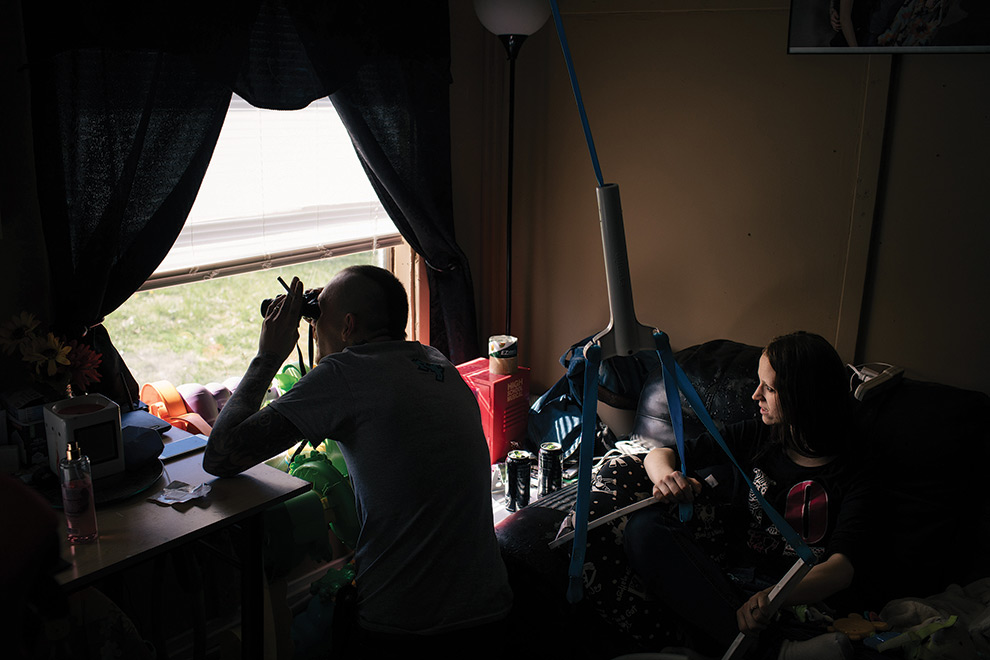
Alyssa Schukar
In January 2017, the Obama administration awarded Life After Hate a $400,000 grant to expand its work and help the Department of Homeland Security identify and fight hate groups. The Trump administration revoked the grant in June 2017, seven weeks before alt-right activists and white supremacists rallied in Charlottesville, Virginia. Life After Hate’s profile was boosted by Trump’s refusal to condemn the deadly violence at the rally and his administration’s policy of playing up threats from Islamists and immigrants while largely ignoring attacks by white supremacists. In 2017, donations shot up from $32,000 to nearly $800,000 (including $50,000 from quarterback Colin Kaepernick).
Confronting white supremacists online and in the streets may feel personally gratifying and politically urgent. Yet as liberals and the anti-Trump “resistance” fawn over Life After Hate, deradicalization activists argue that much of what the left thinks it knows about shutting down racist extremists is misplaced. When it comes to changing individuals, denunciation may counteract rather than hasten deradicalization. If that seems like surrender, consider that some researchers who study hate groups think we should view violent extremism not only as a problem of ideology, but also as a problem of addiction: a craving for group identity, adrenaline, and the psychological kick of hatred. As with substance addiction, there may be no silver bullet for curing extremism, only a lifelong battle to leave such impulses behind. As Peter Simi, a sociologist at Chapman University in California, puts it, “You probably don’t ever fully move on from violent extremism.” The uncomfortable truth is that the best way to reform racist thugs may be to offer them precisely what they aren’t willing to offer others, and precisely what many people in this polarized political moment feel they least deserve: empathy.
After the attack in the park, Johnson was sentenced to eight months of house arrest. He would spend the next three years stumbling in the ideological wilderness before finding Life After Hate, a typical experience for many formers, who often wrestle alone with uncertainty before seeking support.
Johnson was forbidden from seeing his family and co-conspirators, so an acquaintance who wasn’t in the Klan put him up in a trailer about 30 minutes from his dad’s old place. The seclusion allowed the seeds of doubt in Johnson’s mind to germinate into curiosity. He still believed that a secret conspiracy of Jews controlled the media and government, and he considered interracial dating to be race treason. But he wanted to hear the other side of political debates he’d never thought about. So with the same autodidacticism and discipline that had led him to rise through the ranks of the Klan, he began exploring the world on an old pink Toshiba laptop, one Google search at a time.
He started with the left-leaning online news show the Young Turks, but “I’d get mad watching them.” Then he stumbled on George Carlin and Bill Maher clips on YouTube. “I watched [Carlin] and it was like, ‘I fucking hate everything he’s saying, you know, but damn, I love everything he’s saying.’ Bill Maher would be arguing with a Republican. I’m supposed to agree with the Republican, but in my head I’m siding with Bill Maher. I just decided, I got to figure out—Who am I? What is going on with me?”
On Maher’s show he heard the phrase “democratic socialism” and thought, “I ain’t gonna agree with no socialist,” but when he looked it up he thought it made a lot of sense: Maybe he and his family hated black and Hispanic people because racism is a way to keep poor people divided and disorganized. “All of us were poor, none of us had any kinda fancy job. So what else could you be proud of? Well, I’m proud to be white. Then you get this idea that you’re fighting this big racial holy war, you’re somebody of importance, you’re a Grand Dragon. It was so much easier to believe in the conspiracies than just look at yourself in the mirror.”
To try out some of his new ideas—and because he was bored silly—Johnson began commenting on the Facebook page of a group of socialists and Anonymous activists based in Indiana. While he still “supported the militias and skinheads who were on the border shooting the immigrants,” he relished having his arguments picked apart by the commenters. Part troll, part student, Johnson was putting his beliefs through a trial by fire. “And man, they demolished me.”
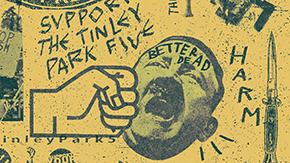
RELATED: Inside the Underground Anti-Racist Movement That Brings the Fight to White Supremacists
The next test came when the page’s moderator, A.C., pinged him one day and introduced himself. A.C., a Mexican American who lived a few hours away in Evansville, saw in Johnson a political pet project—and a bit of himself. Both he and Johnson had had hard lives filled with poverty and violence. They’d had run-ins with the law and disliked the police and the government. The two clicked, and soon they were messaging and talking on the phone almost every day. Johnson revealed his past and why he was under house arrest. A.C. offered him a place to stay if he ever needed one. “If he was just a Mexican guy at my house at the time,” Johnson says, “I would’ve rejected him. But I got to know him without getting to see his skin color.”
The day Johnson’s house arrest ended in mid-May 2014, he and Gregoire drove to the probation office to get his ankle monitor removed. Back in the car, he checked his cellphone. It started to blow up with messages from his cousins and friends. His “sergeant at arms” in the Klan texted to say they were holding a party for him that evening and he should hurry over.
“So,” Gregoire said, “are we going?”
Johnson sat there for a second before dialing A.C. “Remember when you said I could stay with you if I needed to?” Johnson asked him. “Were you serious about that?”
“C’mon, man,” Johnson recalls A.C. replying. “I can get you a job, a place to stay. Everything.”
Johnson and Gregoire fled without any of their possessions. They rolled into Evansville at night. With its rows of decrepit factories and dreary housing projects, it felt like a foreign country. “I was still racist,” Johnson says. “I still didn’t like black people and shit.” At A.C.’s door, they were greeted with a surprise: The Noam Chomsky-quoting socialist had gathered his friends—white, black, Latino—to welcome the crazy Nazi guy they’d heard so much about. They dressed like gangsters, carried guns, and partied just as much as Johnson’s old Klan crew. “This ain’t gonna work,” Johnson worried. “I traded a trailer park for a fucking project.”
One of the most important experiences for nearly all people disengaging from extremism is the sort of stereotype-defying encounter Johnson was having with A.C. In his recent book, Healing From Hate, sociologist Michael Kimmel notes that many former white supremacists he encountered in his research had “met a member of the despised group, one singular individual whose very existence eroded all their categorical group stereotypes, [and] they began to unlearn the dehumanization the movement had taught them.” Like many formers, Christian Picciolini recalls that receiving empathy “at a time when I least deserved it, from those I least deserved it from,” was a transformative event that helped pull him out of the hate movement. For Frank Meeink, it was getting a job from a Jewish business owner. For Arno Michaelis, it was partying with people of different races and political persuasions at raves. For Angela King, it was falling in love with a Jamaican woman. Such interactions can be revelations to people who are already questioning their entrenched worldviews. Life After Hate tries to create these types of encounters, bringing ex-white-supremacists to mosques and events like breakdancing competitions. Picciolini once jumped on a flight to upstate New York when a struggling white supremacist he’d been working with said he was having fantasies about killing Muslims. He took the man to meet an imam.
Kimmel explains the significance of these moments by citing the “contact hypothesis”—the idea that when people are put in intimate settings with those about whom they hold biased views, their stereotypes dissolve. While some have criticized this as an inverted manifestation of white privilege—expecting the oppressed to soothe their oppressors’ guilty conscience—it remains an effective tool.
“We have to make it clear we cannot vilify racists, but we can vilify racism,” says Pardeep Singh Kaleka, who works with Michaelis to promote reconciliation between ex-white-supremacists and their victims. (Michaelis left Life After Hate in 2012 after a fundraising disagreement.) Kaleka’s father was murdered along with five fellow Sikhs in Oak Creek, Wisconsin, by a neo-Nazi in 2012. The killer was a member of the Hammerskin Nation, which Michaelis co-founded. Kaleka admits it can be exhausting to play therapist for white supremacists but says the results are worthwhile. Extremists want their actions to inspire anger. To respond with love, he says, “is the biggest deterrent.”
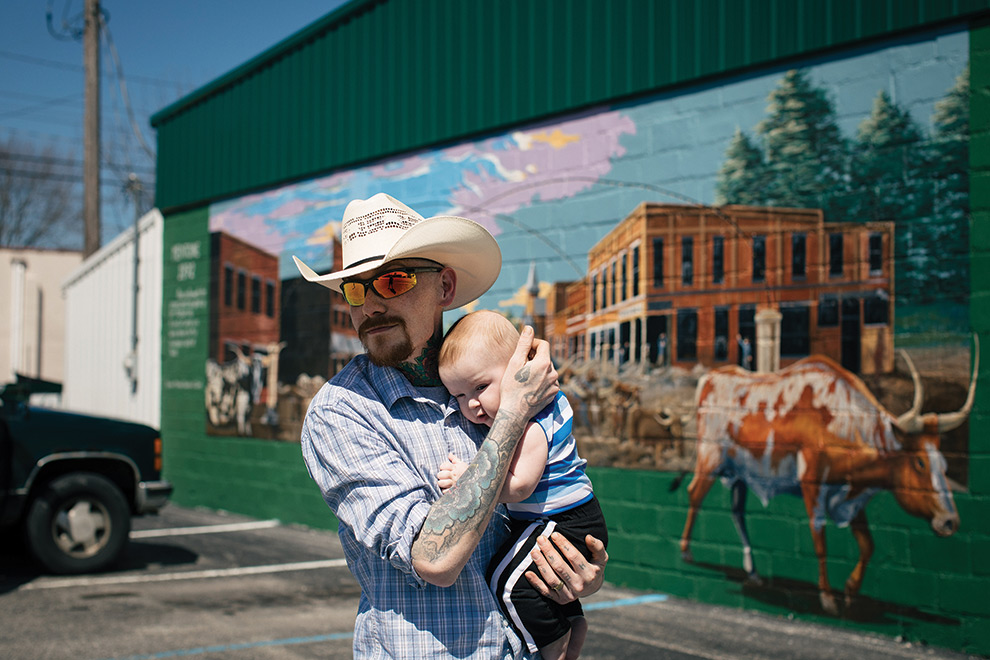
Alyssa Schukar
After a couple of weeks in A.C.’s spare bedroom, Johnson and Gregoire scored their first apartment together. She landed a job at Subway, and he joined A.C. at a plastics manufacturer. Soon after that, he decided to go back to Kokomo to get all their stuff. A.C. and Gregoire begged him not to, but Johnson set out on the four-hour drive.
His dad’s old single-wide sat in a partly abandoned trailer park that had always served as a sort of Klan headquarters. Not surprisingly, within minutes of his arrival, two Klan members, two of his cousins, and one of their girlfriends stormed in as Johnson was stuffing clothes into a trash bag.
Perhaps this is why he’d come back, not for his things, but for a clarifying confrontation. Without so much as a hello or a word about where he’d been, he unloaded on them. “I feel like you guys are all fucking full of shit, this whole lifestyle, this whole belief system,” Johnson remembers telling them. “I feel like you guys forced it on me, and I’ve come to find that I don’t fucking agree with it and I think you guys are fucking idiots. And I don’t want to be a part of it, and I won’t associate with you guys. It’s embarrassing.”
He knew he was spitting on his father’s legacy, in his father’s house no less. In this very living room, he’d plotted race war with his family members and geared up to deliver a beating to race traitors in the park. Now, he’d switched sides.
“So basically what you’re saying,” replied one of the Klansmen, “is you’re a fucking nigger lover? There’s only one cure for a fucking nigger lover, and that’s a goddamn bullet, motherfucker.”
Eventually, the argument fizzled and the visitors left. After hurriedly putting his belongings in the car, Johnson peeled out of the trailer park, watching his dad’s house disappear in the rearview mirror. He stopped for gas and a couple of Monster energy drinks near the highway. He was exhausted from the confrontation, and he still had a long drive back to Evansville.
He heard them before he saw them. Footfalls, boots on asphalt. Just as he finished pumping gas, he turned and found two carloads of Klansmen, some his own relatives, running at him. There was hardly a chance to throw a punch—eight men were suddenly swarming him, so many fists and feet he couldn’t count, practically a whole family reunion hitting and kicking Punchy.
Protect your head, Johnson remembered thinking as he curled up in the fetal position. Don’t get knocked out, don’t get knocked out. Because they’ll stomp your fucking brains out.
They didn’t kill him, but the paramedics who scraped him off the asphalt reckoned they came close, and the doctor who treated him in the emergency room agreed. When Gregoire finally laid eyes on him, he was swaddled in bandages and stuck with IVs and swollen up like he’d suddenly gained 50 pounds. She couldn’t believe how weak and sad he looked. They’d smashed both his eye sockets. Broken his nose. Cracked his jaw. Knocked out his back molars and several front teeth. Broken his left femur, an ankle, both wrists. All his ribs. Most of his fingers. Ruptured his right eardrum so that he’d never hear on that side again. When he came to and saw Gregoire, his first thought was, She’s all I got left now.
Rather than confirming how toxic the lifestyle he’d left behind was, the beating paradoxically made Johnson regret quitting the Klan. Simi attributes some of the durability of extremist ideology to its “master status”: It’s a form of identification that cuts across all aspects of a person’s life. Unlike mainstream political affiliations, it’s an all-consuming marriage of belief, community, and action—more like family or cultural identity. Most people are active Democrats or Republicans once every two or four years. Yet an extremist is an extremist every single day; it infuses everything he does. When it’s gone, there’s nothing left.
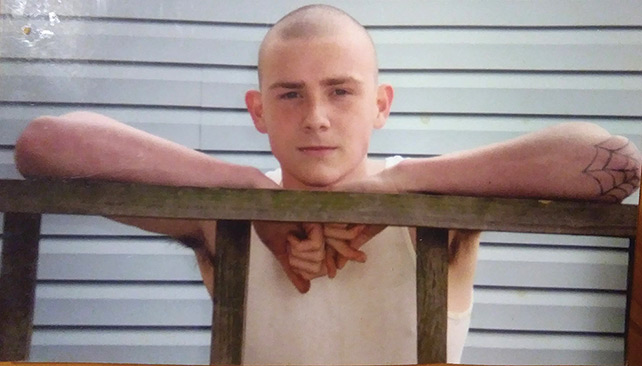
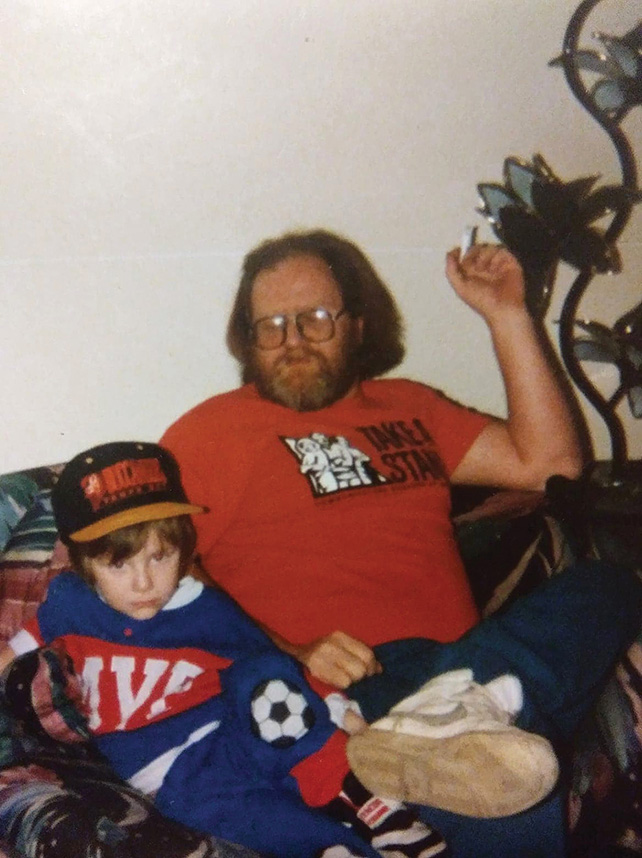
Shane Johnson
Leaving extremism creates a void, and becoming a former doesn’t necessarily fill it. Life After Hate co-founder Frank Meeink’s life fell apart when he got out of the neo-Nazi movement in Philadelphia. After he became a sought-after public speaker and a darling of the Anti-Defamation League, he got hooked on heroin and overdosed in front of his son. “I was so fucking close to the dream, but I couldn’t wake up from the nightmare,” Meeink wrote in his memoir, Autobiography of a Recovering Skinhead. “I couldn’t stand to be me, unfiltered, unprotected…I never had the guts to take a searching and fearless moral inventory of myself.” As a skinhead, he’d rejected drugs, but once he got out of the movement, his “whole anti-drug stance began to crumble.”
Researchers have just started to understand possible connections between participation in hate movements and addiction. A recent peer-reviewed study by Simi and three co-researchers found that intense experiences with violence and music can trigger dopamine responses similar to drug use. Over time, they found, extremist identities “may generate neuro-psychological changes that…mimic addiction.” Extremists may beat people up or listen to hate music both to reinforce their beliefs and to get a kick. “I can listen to white-power music and within a week be back in that mindset,” a former member of the American Nazi Party told Simi. “I guarantee you it’s an addiction.”
Simi and fellow researchers have since conducted a follow-up experiment in which they showed images of interracial couples, swastikas, and violent imagery to five former white supremacists while scanning their brains. The images activated pathways in their frontal lobes that suggest previous experiences with extremist ideologies may have generated “reservoirs of heightened levels of emotionality,” much in the way an addict’s brain may be forever transformed by past drug use. The study is preliminary, but Simi believes his research might offer promising evidence that the process of shedding extremist identities “can be experienced as a struggle against addiction, with continuing cognitive, emotional, and physiological responses,” which means that lessons learned from treating addiction might inform how we treat extremism.
This could be one reason why many extremists turn to drugs or alcohol while they’re trying to leave the movement, suggests Life After Hate director Rangel, who trained as a social worker. He points out that many people he works with are struggling from “overlapping issues” of poverty, alcohol and substance abuse, and mental health problems.
After two weeks in the hospital, Johnson went back to Evansville. He was too injured to work and too depressed to care about spiffing up the apartment. He started drinking more, washing down prescription pills with beer for breakfast. The Klan “was my life, and I lost all of it,” he said. “It didn’t just hurt physically. It hurt because I just lost my family. It really sunk in, like, ‘Dude, you just outed yourself from your life, from your belief system. And what if you’re fucking wrong?’” He considered suicide. After so many years of living in a fantasy propped up by his comrades, it was intolerable to suddenly be so alone and powerless. “If this is what it’s like to live on the other side,” he recalls thinking, “I’d rather be in the Klan than be a part of this shit.”
It took nearly a year, and the discovery of a new, inspiring narrative, for Johnson to begin emerging from the fog of depression and substance abuse. Gregoire told him he’d quit extremism for a reason: “Now figure out what that reason was.” It turned out to be, in part, his desire to become a crusader against his former lifestyle. He resolved to fight back by going public with his own story, exposing life inside the Klan in the hope that it would stop other people from joining—and deprive his family of the power they wielded over him. “Fuck these motherfuckers, man. They take away my whole fucking life from me and get mad when I try to take it back?” He didn’t know where he’d find an audience or if anyone would care what he had to say. But he was convinced that “people don’t know what the fuck they’re getting into when they join this shit,” and it was his mission to keep them out of it.
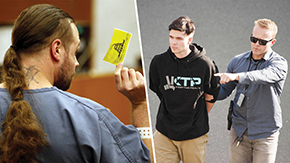
RELATED: The White House Says White Supremacist Terror is Fake News. It’s Not.
He and A.C. volunteered with the Bernie Sanders campaign, door-knocking and canvassing in the summer of 2015. Even when it was 90-plus degrees, Johnson wore a turtleneck to hide the tattoos on his neck. Standing on doorsteps and stoops, he began telling his story in bits and pieces—not always with the desired effect. “I scared the crap out of some people,” he recalls. “I should’ve door-knocked for Trump. Maybe then Trump would’ve lost.”
In June 2016, Johnson appeared on a local news segment after speaking with a reporter while getting the tattoos on his throat covered up. “Hey bud I read your story,” Christian Picciolini messaged him on Facebook. “My story is a lot like yours, would love to talk about it some time.”
Picciolini often began recruiting new members to Life After Hate with this soft approach. “It’s usually a pretty tenuous time for somebody if it’s their first outing,” he says. Picciolini knew from experience that getting out could take much longer than expected, and that “you might think you’re fully out, but you’re not.” When he quit his role as a leader of the Hammerskin Nation at age 22, his wife and children had just left him, and he went through five years of severe depression. It wasn’t until the 2011 meeting in Dublin that Picciolini began building a new life. By contacting Johnson, he says, “I just wanted to make him feel comfortable and that there was somebody else out there like him who had been through it.”
Picciolini’s intervention was well timed. Though it had been three years since Johnson started cutting ties with the Klan, he still privately dealt with “residuals,” a term Simi cribbed from addiction studies to refer to involuntary racist thoughts or actions that can persist for years after someone has disengaged from extremism. “It took me less than two years to learn to hate,” a former member of a paramilitary group told Simi, “and it took me nine years to unlearn it.” Johnson had by now completely rejected Christian Identity theology, but he still couldn’t pick up the Bible without seeing evidence that Jews and African Americans didn’t have souls, or that God demanded their enslavement and extermination. “It’s kind of like a drug addiction,” Johnson says. “You have to admit you have a problem to fix the problem.” Sometimes when he saw interracial couples, he instantly thought, “Race traitor.” He wondered if he’d changed at all.
In Simi’s 2017 study, dozens of formers reported having these unwanted thoughts and sometimes acting on them, seemingly against their own will. One woman recounted how she flew into a rage at a restaurant, calling a Hispanic employee a “beaner” and throwing a Nazi salute before realizing what she’d done. A man who’d been out for more than 15 years described getting furious when his daughter started dating a Mexican American man: “I was just like, ‘Don’t fucking think that you are all cured of fucking racism, Mr. Fucking Racist.’”
To help new members deal with residuals and other issues, Life After Hate provides recruits with advice by phone, occasional in-person meetings, and a private Facebook support group where they can commiserate, seek guidance, or just vent. In the Facebook group, Johnson learned that his feelings were common among virtually all formers. He wrote that he was having a hard time. Meeink, who’d also been a believer in Christian Identity theology as a neo-Nazi in the 1990s, replied, and they talked on the phone for three hours.
If research bears out the connections between extremism and addiction, it might shift the framework of deradicalization toward an Alcoholics Anonymous-type model where formers must manage their violent, racist urges to stay “sober.” (This might also require Life After Hate to expand its staff to include therapists, social workers, and others who can provide services that many formers can’t offer.) That could be a healthy lesson for all Americans struggling with prejudice: There’s no magic cure, no such thing as a “life after hate,” only a life of fighting not to succumb to it.
In February 2018, Johnson met Life After Hate’s leadership in person for the first time. The group had been collaborating with a Seattle-based creative agency called Possible, which had created an app called WeCounterHate that uses artificial intelligence to identify “hate tweets.” (The company tracked more than 1 million hate tweets in December 2017.) The program would reply to each hate tweet, explaining that every time the original message was retweeted, $1 would be donated to Life After Hate. Life After Hate was asked to offer feedback on the prototype, and Angela King, now the group’s program director, invited Johnson along. She thought the trip would expose him to unfamiliar people and places and possibly help him grow into a leadership role.
Sitting at a conference table topped with sparkling water and Kind bars, Johnson looked out of place with his black cowboy hat, cowboy boots, and shaved head. His arms still sported swastika tattoos he couldn’t afford to remove. “This is freakin’ disgusting,” he said, after someone convinced him to try a LaCroix. He asked if they had Monster energy drinks.
Ray Page, then Possible’s executive creative director, presented a slideshow of the WeCounterHate prototype. Part of the day’s agenda was to fine-tune its Twitter replies so that they wouldn’t alienate the white supremacists they were designed to target. The message was supposed to direct extremists to Life After Hate: “If you’re tired of living in the darkness of a hate-filled life, there’s a way out. No judgment. Just help.”
The Life After Hate members thought the language was too condemning and would antagonize someone flirting with leaving extremism; they thought it would make people double down. “Rather than shaming them as living dark, hate-filled lives,” Johnson said, placing his hat on the table, “you need to challenge them to engage. The whole belief system is that I was right and you were wrong. You weren’t blessed with the knowledge I had. So you can’t just tell me I’m wrong.”
“That might look good to you guys,” Thomas Engelmann, a new recruit who’d flown in from Mississippi, told Page. He had left the Aryan Brotherhood in 2016 and had been shot in the face in retaliation. He had lost his right eye and most of the sight in his left. He wore an eye patch, and a black Labrador guide dog sat at his feet. “But if I saw that,” Engelmann continued, “I’d say, ‘Kiss my ass!’”
“You’re communicating what you think about them,” added Rangel, “but that doesn’t really do any good.”
Page seemed deflated. “I want to change it, like, today,” he said. “The more I look at that, the more it’s like advertising copy that shames people for not subscribing to a newsletter.”
“We need a helping hand,” Engelmann added, “not a hand in our face.”
The conversation underscored how well-intentioned responses to extremism can backfire, particularly online, where outrage and virtue signaling can be counterproductive. That’s not to say you must tolerate extremists’ ideas. But if you want to prod people to leave the movement, invective isn’t effective.
The day exposed other fault lines that run beneath Life After Hate’s work. That morning, Johnson and Rangel had gotten into an argument about why the former leader of a Latino gang was running an organization for ex-white-supremacists. New members have voiced other frustrations with the group’s older leadership. Some told me Life After Hate’s Facebook support page is largely inactive, with fewer than 50 participants, most of whom rarely comment. One member says it seems like the group contacts him mostly when it wants him to appear in one of its film projects. Rangel is working to finish a feature-length documentary; King just completed production of a virtual reality film that’s supposed to help viewers understand how hate groups radicalize vulnerable people. (The film is being made by Oculus, whose founder, Palmer Luckey, has faced criticism for his alt-right connections and for funding a dark-money group dedicated to generating pro-Trump memes.)
Even Simi, who is a Life After Hate board member, sees the group struggling to balance its media profile with new recruits’ needs. “Public talks are a great way to get the word out and create that public face and persona,” he says, “but if so much of your resources and time and energy are going to that, when are the services going to be delivered?”

Alyssa Schukar
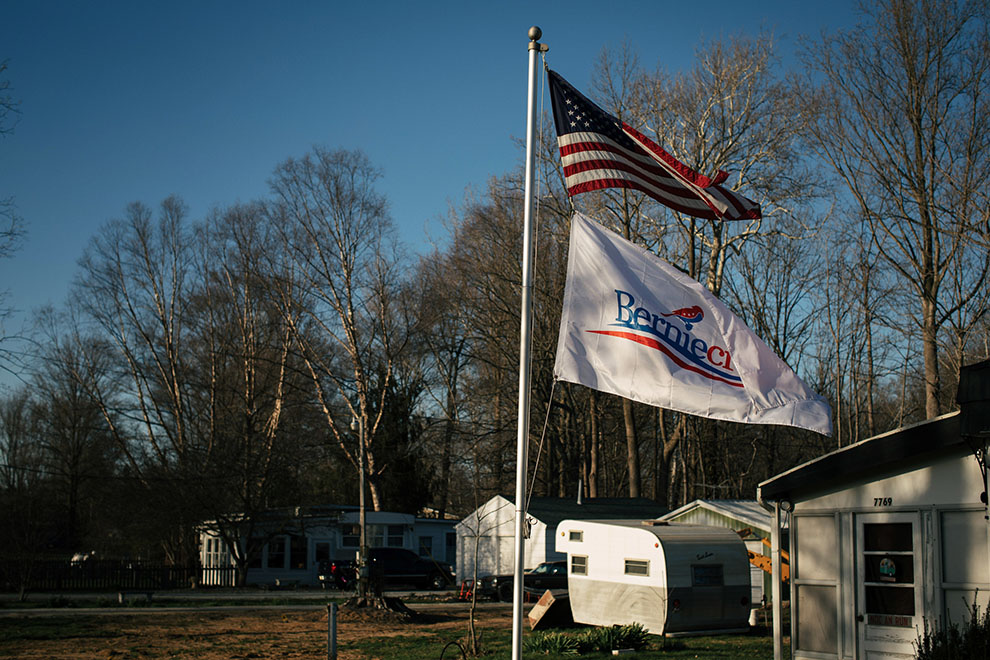
Alyssa Schukar
Nasty feuds between the organization’s founders have also threatened to undermine its work. In addition to Michaelis, other high-profile members have fallen out with Life After Hate: Picciolini left in August 2017, after a homeland security official blamed his anti-Trump tweets for costing the group its federal funding. (He has since created a new deradicalization effort, the Free Radicals Project.) “If I were a newer dropout,” Johnson says, “the infighting would only reinforce that these types of groups are frauds and push me back into the arms of the white power movement.” Rangel acknowledges that things can get messy behind the scenes: “What would you expect when you collect a group of ex-assholes who are at various stages of their life change?”
Back in the boardroom, a disagreement was brewing between the recruits and the older members about the threat posed by the mainstreaming of white nationalism and a new generation of extremists who are radicalized online. According to the Southern Poverty Law Center, KKK membership has decreased as the alt-right movement has deemphasized “Klan robes and Nazi symbols in favor of a more ‘intellectual’ approach.”
“Gamers don’t get violent in real life,” claimed Tony McAleer, one of the Life After Hate co-founders. McAleer, who is 50 and left the extremist movement in the ’90s, said he thought “4chan nerds” didn’t pose nearly as much of a threat as skinheads or neo-Nazis once did. “They’re not physically capable of committing violence.”
Johnson and Engelmann, millennials who grew up with the internet, exchanged skeptical glances.
“It’s a really big error to discount those people,” Engelmann said. “They turn into the school shooters, the bombers.” The dichotomy between real-life extremists and online wannabes was a false one, he suggested. “Look at Dylann Roof”—who murdered nine black churchgoers in Charleston, South Carolina, in 2015. “He went seamlessly from the internet to murder.”
After the exchange, Engelmann leaned on the table and whispered to Johnson, who was seated beside him, “They don’t know shit. They’ve been out 20 fucking years.”
“You don’t have no younger motherfuckers to come around here?” Johnson replied quietly, and the two men chuckled.
Last year, Johnson landed a good job with Tyson near Kokomo, and he and Gregoire took the surprising step of moving close to his hometown. Part of his new identity—just like his old identity—demands not backing down from confrontation, and besides, at heart he is a country boy. He and Gregoire got married and bought a trailer and some land on a dead-end dirt road beside a river where they hoped no one would bother them. Last September, they had a son, Wyatt.
Not long after that, a car came screeching to a stop in front of the trailer, and the driver shouted at Johnson, who was outside doing yardwork: “White power!” On a visit to his father’s grave in Kokomo, two carloads of Klansmen chased him out of town. He says he has weapons hidden throughout his property, and he keeps a shotgun in his bedroom. “You ain’t gonna catch me slipping,” he says. “They done got me once. It won’t happen again.”
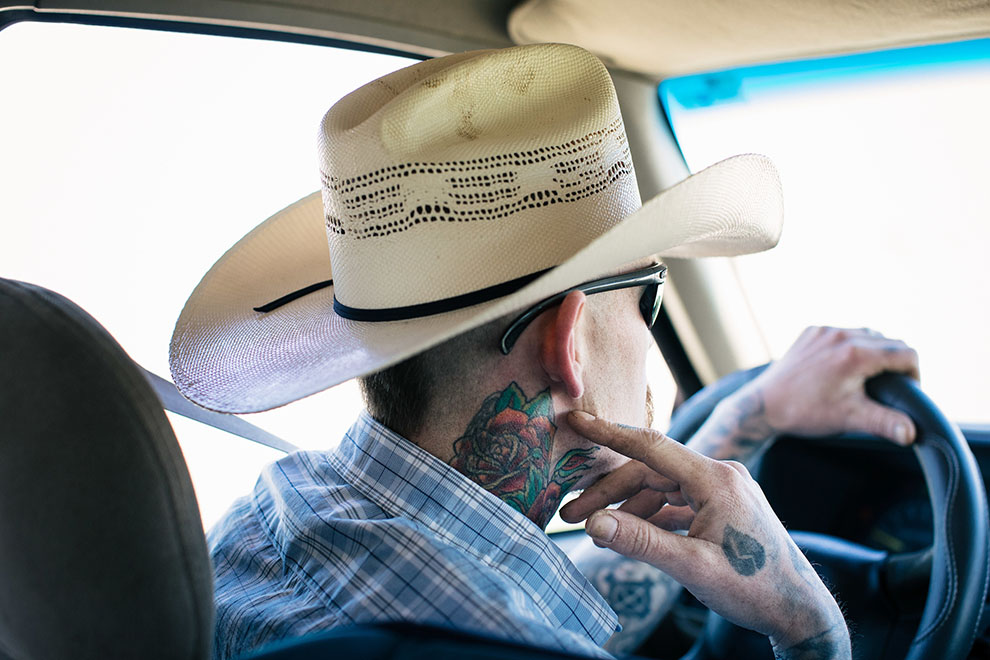
Alyssa Schukar
He’s embracing, even enjoying, his role as a former. Whatever its faults, Life After Hate has helped create a redemption narrative for the Trump era. Being a “former” is a new political identity, one that offers a future to folks like Punchy: Leaving behind hate doesn’t mean you have to hide your past or despise yourself. In this way, it provides a new set of Kruglanski’s three Ns. Johnson’s mission now is to link up with others like him to proselytize against hate. “I’m blessed with the opportunity to get the message out there,” he says, “and all I can do is humble myself and tell the fucking truth. I believe the truth can keep people from joining.”
In recent months, Gregoire has brought friends in interracial relationships over for dinner. Johnson helped a co-worker who expressed some doubts about his involvement in the Aryan Brotherhood connect with Life After Hate. He argues with friends and neighbors when they make racist comments. He’s started to really like rap. Not long ago, someone asked him what he does for a living and he replied, “I’m a civil rights activist.”
He’s also been messing with Nazis and Klansmen online, small acts of sabotage that he asked me not to reveal in detail. On a spring afternoon, he logged on to his computer, chuckling as he read the emails from a high-profile KKK leader in the South who had known his father and whom Johnson was now catfishing as part of his psy-ops schemes. Wyatt sat on the couch, giggling at nothing in particular.
“Even if I never do nothing else in my life right there,” he said, “Wyatt will be my biggest accomplishment—the first generation of Johnson not born into the Klan.” On the wall beside him was a sign handwritten in blue marker, a reminder of how far he’d come and how far he might still have to go. “Racism is not normal,” it said. “Stay focused. Never forget that you were once the same way!”

